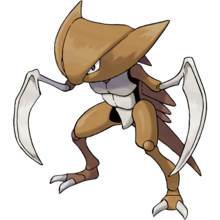|
|

Artwork from FR/LG
|
|
|
|
|
|
|
|
|
|
|
|
Height
4'03"
Imperial
|
1.3 m
Metric
|
4'03"/1.3 m
Red-Striped
|
0'0"/0.0 m
Blue-Striped
|
0'0"/0.0 m
|
|
|
Weight
89.3 lbs.
Imperial
|
40.5 kg
Metric
|
89.3 lbs./40.5 kg
Red-Striped
|
0.0 lbs./0.0 kg
Blue-Striped
|
0.0 lbs./0.0 kg
|
|
|
|
|
|
|
|
|
|
|
|
|
EV yield
HP
0
|
Atk
2
|
Def
0
|
Sp.Atk
0
|
Sp.Def
0
|
Speed
0
|
| Base Exp.: 199
|
Battle Exp.: 1991*
|
|
|
|
|
Kabutops (Japanese: カブトプス Kabutops) is a dual-type Rock/Water Pokémon.
It evolves from Kabuto starting at level 40.
Biology
Kabutops is a fossil Pokémon no longer found in the wild, and must be evolved from a Kabuto resurrected from a Dome Fossil.
Physiology
Kabuto's four insect-like legs have vanished and two long feet stand in their place. Two long sharp claws (or sickles) extend from Kabutops's exoskeleton and several plates close the opening that used to be there. There are six hard spikes going down from the back of its neck, three on each side that lead down towards the beginning of its tail. Its head is covered in a rock hard, semicircular shape armor. A tail protrudes from its back, bearing the same color as approximately seventy-five percent of its body. Its gills have also begun to change to make it land compatible.
Gender differences
None.
Special abilities
Kabutops's sleek body enables it to swim faster by tucking in its limbs, folding up its claw-like sickles and wiggling.
Behavior
Kabutops is a fierce prehistoric predator. Adaptations in its body permit it to lead a more terrestrial lifestyle than its predecessors. It is also very adaptive as shown when its prey started living on land so Kabutops adapted to living on land as well.
Habitat
The exact habitat of Kabuto is unknown, but so far Dome Fossils are only found in the Kanto and Sinnoh regions. But other facts would leave one to believe that Kabutops and Kabuto may have lived in the sea and in caves, although Kabutops could walk ashore on its newly developed legs.
Diet
- Main article: Pokémon food
Kabutops cuts open prey with its claws, then sucks up the spilled bodily fluids. In ancient times it hunted underwater for its prey.
In the anime
Kabutops first seems to appear in Island of the Giant Pokémon on a theme park island populated with giant mechanical Pokémon.
Kabutops's first true appearance in Attack of the Prehistoric Pokémon. It was one of the fossil Pokémon that was awakened by a dynamite explosion in Grandpa Canyon.
Kabutops also appeared in Pokémon Heroes. Oakley used ancient DNA to resurrect a Kabutops and an Aerodactyl to chase after Ash and Latias. In the English dub, they were once used by an evil Pokémon Trainer to torment the civilians of Alto Mare, but were drowned when a Latios brought water to the city.
Dr. Yung uses a Mirage Kabutops in The Mastermind of Mirage Pokémon.
Another one appeared in Dealing With Defensive Types!.
Pokédex entries
| Episode
|
Pokémon
|
Source
|
Entry
|
| EP046
|
Omanyte, Omastar, Kabuto, and Kabutops
|
Ash's Pokédex
|
Omanyte and Omastar, Kabuto and Kabutops. It is believed these Pokémon became extinct tens of thousands of years ago. The details of their behavior are shrouded in mystery. Though some have speculated that they may still exist, none of these Pokémon have ever been seen alive.
|
|
In the manga
Pokémon Special
In Template:PSV, Brock possesses a Kabutops in his team. He explains that he met Kabutops at the Pewter Museum when Pewter City was invaded during the Elite Four saga, and has since then become a powerful fighter employing ancient attacks.
In the TCG
- Main article: Kabutops (TCG)
Game data
NPC appearances
Pokédex entries
| This Pokémon was unavailable prior to Generation I.
|
| Generation I
|
|
| Red
|
Its sleek shape is perfect for swimming. It slashes prey with its claws and drains the body fluids.
|
| Blue
|
| Yellow
|
A slim and fast swimmer. It slices its prey with its sharp sickles and drinks the body fluids.
|
| Stadium
|
Swims very quickly. It tears at its foe with sickle-like forelegs and drains the foe's body fluids entirely.
|
|
|
| Generation II
|
|
| Gold
|
In the water, it tucks in its limbs to become more compact, then it wiggles its shell to swim fast.
|
| Silver
|
With sharp claws, this ferocious, ancient Pokémon rips apart prey and sucks their body fluids.
|
| Crystal
|
It was able to swim quickly through the water by compactly folding up its razor-sharp sickles.
|
| Stadium 2
|
In the water, it tucks in its limbs to become more compact, then it wiggles its shell to swim fast.
|
|
|
| Generation III
|
|
| Ruby
|
Kabutops swam underwater to hunt for its prey in ancient times. The Pokémon was apparently evolving from being a water-dweller to living on land as evident from the beginnings of change in its gills and legs
|
| Sapphire
|
Kabutops swam underwater to hunt for its prey in ancient times. The Pokémon was apparently evolving from being a water-dweller to living on land as evident from the beginnings of change in its gills and legs
|
| Emerald
|
Kabutops once swam underwater to hunt for prey. It was apparently evolving from being a water dweller to living on land as evident from changes in its gills and legs.
|
| FireRed
|
It swims freely through water. It catches prey with its scythe-like arms and drains the victim's fluids.
|
| LeafGreen
|
Its sleek shape is perfect for swimming. It slashes prey with its claws and drains their fluids.
|
|
|
| Generation IV
|
|
| Diamond
|
It is thought that this Pokémon came onto land because its prey adapted to life on land.
|
| Pearl
|
It is thought that this Pokémon came onto land because its prey adapted to life on land.
|
| Platinum
|
It is thought that this Pokémon came onto land because its prey adapted to life on land.
|
| HeartGold
|
{{{heartgolddex}}}
|
| SoulSilver
|
{{{soulsilverdex}}}
|
|
|
|
|
|
|
Game locations
| This Pokémon was unavailable prior to Generation I.
|
|
|
|
|
|
|
|
|
|
|
|
|
In side games
Base stats
| Stat
|
Range
|
| At Lv. 50
|
At Lv. 100
|
60
|
|
120 - 167
|
230 - 324
|
115
|
|
108 - 183
|
211 - 361
|
105
|
|
99 - 172
|
193 - 339
|
65
|
|
63 - 128
|
121 - 251
|
70
|
|
67 - 134
|
130 - 262
|
80
|
|
76 - 145
|
148 - 284
|
Total: 495
|
Other Pokémon with this total
|
- Minimum stats are calculated with 0 EVs, IVs of 0, and (if applicable) a hindering nature.
- Maximum stats are calculated with 252 EVs, IVs of 31, and (if applicable) a helpful nature.
- This Pokémon's Special base stat in Generation I was 70.
|
Type effectiveness
| Under normal battle conditions in Generation V, this Pokémon is:
|
|
|
|
|
|
|
|
|
|
|
|
|
Learnset
Template:Learnset intro
|- style="text-align:center"
| style="text-align:left" | rock
| style="background:#2980EF" | water
| style=" background:#FFF" | 4
| style=" background:#FFF" | 1
| style=" background:#FFF" | Kabutops
| style="display:none; background:#FFF" | {{{6}}}
Template:Mlentry4
Template:Mlentry4
Template:Mlentry4
Template:Mlentry4
Template:Mlentry4
Template:Mlentry4
Template:Mlentry4
Template:Mlentry4
Template:Mlentry4
Template:Mlentry4
Template:Mlentry4
Template:Mlentry4
Template:Mlentry4
Template:Mlentry4
Template:Mlentry4
Template:Mlentry4
Template:Mlentry4
Template:Movelist/note
Template:Movelisttm
Template:Mlentry4
Template:Mlentry4
Template:Mlentry4
Template:Mlentry4
Template:Mlentry4
Template:Mlentry4
Template:Mlentry4
Template:Mlentry4
Template:Mlentry4
Template:Mlentry4
Template:Mlentry4
Template:Mlentry4
Template:Mlentry4
Template:Mlentry4
Template:Mlentry4
Template:Mlentry4
Template:Mlentry4
Template:Mlentry4
Template:Mlentry4
Template:Mlentry4
Template:Mlentry4
Template:Mlentry4
Template:Mlentry4
Template:Mlentry4
Template:Mlentry4
Template:Mlentry4
Template:Mlentry4
Template:Mlentry4
Template:Mlentry4
Template:Mlentry4
Template:Mlentry4
Template:Mlentry4
Template:Mlentry4
Template:Mlentry4
Template:Mlentry4
Template:Mlentry4
Template:Mlentry4
Template:Mlentry4
Template:Mlentry4
Template:Mlentry4
Template:Mlentry4
Template:Mlentry4
Template:Movelist/note
Template:Eggmoves
Template:Mlentry4
Template:Mlentry4
Template:Mlentry4
Template:Mlentry4
Template:Mlentry4
Template:Mlentry4
Template:Mlentry4
Template:Mlentry4
Template:Mlentry4
Template:Mlentry4
Template:Eggmoves/note
Template:Tutor
Template:Mtentry4
Template:Mtentry4
Template:Mtentry4
Template:Mtentry4
Template:Mtentry4
Template:Mtentry4
Template:Mtentry4
Template:Mtentry4
Template:Mtentry4
Template:Mtentry4
Template:Mtentry4
Template:Mtentry4
Template:Mtentry4
Template:Mtentry4
Template:Mtentry4
Template:Mtentry4
Template:Mtentry4
Template:Mtentry4
Template:Mtentry4
Template:Mtentry4
Template:Mtentry4
Template:Mtentry4
Template:Mtentry4
|- style="background:#CBC7AD"
| colspan="13" | Bold indicates a move that gets STAB
Italic indicates a move that gets STAB only from an Evolution of this Pokémon
A colored initial indicates that the move is not available to be tutored in this game,
while a colored background indicates that the move is available.
|}
|}
Side game data
Template:Side game
Evolution
Template:Evobox/1
Sprites
Trivia
- "Lantis," from the word "Atlantis," was the prototype name for Kabutops.
- In Generation I, Kabutops had a large diamond shaped plate on its back that was replaced in Generation II by a horn-like extension of its head.
- Kabutops' shiny colors are Scyther's normal colors.It is possible that Kabutops to be the prehistoric form of Scyther.
Origin
Similarly to how Kabuto is based on horseshoe crabs, it resembles eurypterids, prehistoric arthropods which hunted in seas and rivers and are believed to have been related to modern horseshoe crabs. The large head is also identical to the cephlon in trilobites and the spines down the back resemble thoracic sections in trilobites, though the scythes and predatory nature much more closely resemble eurypterids.
Name origin
The kabuto in Kabutops's name could be derived from 兜 kabuto, helmet, referring to its shape and rock-like properties. Its head has a resemblance to a 兜蟹 kabutogani, horseshoe crab. Tops might mean that it is the "the top" in its evolutionary line. It could also be a reference to the extinct creature triceratops, ceratopsidae in general or triops.
In other languages
External links
Notes

|
This Pokémon article is part of Project Pokédex, a Bulbapedia project that aims to write comprehensive articles on each Pokémon species, as well as Pokémon groups and forms.
|








































